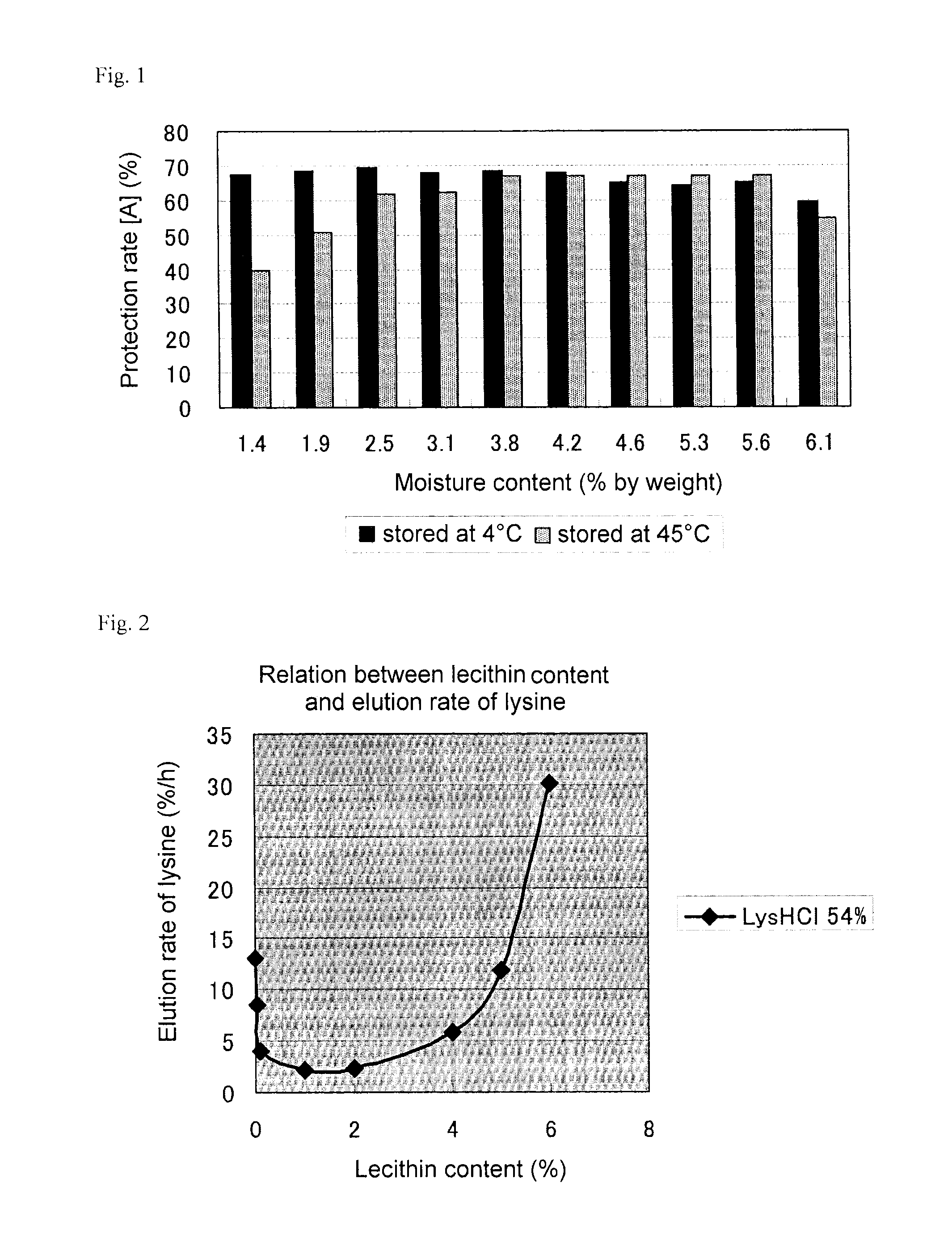Feed additive composition for ruminants and method of producing the same
a technology of additive composition and ruminant, which is applied in the field of feed additive composition for ruminants, can solve the problems of difficult to say that the prevention of the loss of amino acids in the rumen, especially basic amino acids, is sufficiently accomplished, and the contents of amino acids in preparations become relatively scarce, so as to achieve the effect of enhancing milk yield and production, enhancing the amount of production of feed additive composition, and high basic amino acid conten
- Summary
- Abstract
- Description
- Claims
- Application Information
AI Technical Summary
Benefits of technology
Problems solved by technology
Method used
Image
Examples
example 1
[0071]Since the amount of soybean lecithin used was a trace amount, in order to uniformly disperse this, soybean lecithin was triturated in advance by a mixing granulator using finely pulverized L-lysine monohydrochloride (the composition ratio was L-lysine monohydrochloride:soybean lecithin=5:1). Three components, that is, finely pulverized L-lysine monohydrochloride for feed having an average particle size of 75 μm (manufactured by Ajinomoto Co., Inc.), soybean lecithin (manufactured by Ajinomoto Co, Inc.) and fully hydrogenated soybean oil (melting point 67° C.; manufactured by Yokozeki Oil & Fat Corp.) were respectively weighed at the composition shown in Table 1, including the above-mentioned amount of soybean lecithin, and so as to obtain a total amount of 5 kg, and the three components were sufficiently mixed. In addition, as the amino acid for invention 10, a mixture formed by adding 6.0% by weight of DL-methionine (manufactured by Ajinomoto Co., Inc.) to 42% by weight of L-...
example 2
[0076]17.7 kg of L-lysine monohydrochloride for feedstuff (manufactured by Ajinomoto Co., Inc.) which was pulverized to a particle size of 100 μm or less was charged into a Nauta Mixer NX-S (manufactured by Hosokawa Micron, Ltd.), and 3.5 kg of soybean lecithin (manufactured by Ajinomoto Co., Inc.) was added and mixed therewith while being stirred. 1.3 kg of the mixture, 9.9 kg of the above-mentioned L-lysine monohydrochloride, and 8.8 kg of fully hydrogenated soybean oil (manufactured by Yokozeki Oil & Fat Corp.; melting point 67° C.) were mixed with the Nauta Mixer. Subsequently, the mixture was charged into a twin-screw extruder (manufactured by Cosmotec Corp.) having the inside of the screw heated to 85° C., and the slurry-like molten mixture discharged from the outlet was charged into a multi-hole shooter (number of holes: 30, size of hole: 2 mm in diameter). The slurry-like molten mixture was dropped into a stirred water tank which was installed at a distance of 20 cm from tho...
example 3
[0077]1) Composition raw materials which had been mixed in advance to a weight ratio of 54.9% of L-lysine monohydrochloride (manufactured by Ajinomoto Co., Inc.), 1.1% of soybean lecithin (manufactured by Ajinomoto Co., Inc.) and 44% of fully hydrogenated soybean oil (melting point 67° C.; manufactured by Yokozeki Oil & Fat Corp.) were charged into the hopper of a twin-screw extruder for laboratory use (Laboruder Model Name: Mark-II, manufactured by Japan Steel Works, Ltd.), and the composition raw materials were continuously fed at 9 kg / h from the hopper into the feed inlet of the rotating (400 rpm) screw which had been preliminarily heated (preliminary heating temperature 60° C., main heating temperature 85° C., set temperature for outlet 70° C.). The molten mixture was conveyed into the screw to be heated, melted and mixed, and was discharged from the outlet of the extruder with its die plate removed, in the form of finely textured, uniform molten slurry. The discharged molten mi...
PUM
 Login to View More
Login to View More Abstract
Description
Claims
Application Information
 Login to View More
Login to View More - R&D
- Intellectual Property
- Life Sciences
- Materials
- Tech Scout
- Unparalleled Data Quality
- Higher Quality Content
- 60% Fewer Hallucinations
Browse by: Latest US Patents, China's latest patents, Technical Efficacy Thesaurus, Application Domain, Technology Topic, Popular Technical Reports.
© 2025 PatSnap. All rights reserved.Legal|Privacy policy|Modern Slavery Act Transparency Statement|Sitemap|About US| Contact US: help@patsnap.com

